
California’s passage of AB 1138—also known as part of the California Film & Television Jobs Act alongside SB 630—could have a meaningful impact on Hollywood’s competitiveness. Here’s how:
What AB 1138 Does
1. Increases base tax credit rates
- Raises the base credit from 20–25% to 35% or 40%, depending on production type.
- Adds a bonus uplift (5%) for shooting outside the L.A. zone, in economic opportunity zones, or for visual-effects work.
2. Broadens eligibility
- Expands “qualified motion pictures” to include live-action and animated series, animated films, and large-scale competition shows—plus half-hour comedies that were previously excluded
3. Doubling the annual cap
- Increases the total annual tax credit cap from $330 million to $750 million, pending budget approval
4. Algebraic flexibility
- Grants the California Film Commission more flexibility to allocate credits across different categories—feature films, TV series, or independent projects
Expected Impact on Hollywood
Attraction & Retention
- With more generous credits and a higher cap, California becomes more competitive against states like Georgia and countries like the UK and Canada that already offer robust incentives
- Including half-hour comedies could recapture projects that have been filming elsewhere (e.g., Cobra Kai in Atlanta)
Jobs & Economic Boost
- Supporters argue that each dollar in tax credits generates over $1.07 in state/local tax revenue and $8.60 in wages, fueling middle-class jobs and supporting small businesses
Halting production exodus
- Production in Los Angeles dropped ~30% compared to five-year averages, and about half of projects didn’t qualify under the old rules—these changes aim to reverse that trend
Implementation timeline
- Assembly passed AB 1138 June 4, with a vote of 73–1; Senate passed SB 630 similarly. The plan is to finalize everything—including Gov. Newsom’s proposed $750 M cap—in the new state budget and implement it starting July 1, 2025
Bottom Line
AB 1138 represents a significant strategic push to reinforce California's status as a global entertainment hub. By increasing incentives, expanding eligibility, and increasing funding, the legislation aims to:
- Attract productions that left for cheaper locales.
- Retain diverse content genres, including animation and half-hour comedies.
- Protect jobs, infrastructure, and economic ecosystem across studios, vendors, and support industries.
However, the measure’s ultimate effectiveness depends on finalization in the 2025–26 budget and seamless implementation by the California Film Commission before the end of the legislative session in September 2025.
While AB1138 is pitched as a revival tool for California’s film sector, critics argue it is unlikely to solve core structural problems and may perpetuate inefficient government spending without meaningful industry reform.
Opinion:
The act still excludes many of the pieces of the puzzle, like the 'above the line' crew, infrastructure, regulations, and long term stability of the industry. The Hollywood Incentives Bill feels like it's a year late and a half a billion dollars short. Hollywood will become a tourist destination where people go to 'experience the dream of yesteryear'.
Chris Sturges, Business Development Director for
Suspiciously Convenient Productions Inc
Contact: chris@suspiciouslyconvenient.com
Tags: #Global Film Production #Film Industry Trends #Future Of Filmmaking
#New Film Hubs #World Cinema Growth #Hollywood Trends



